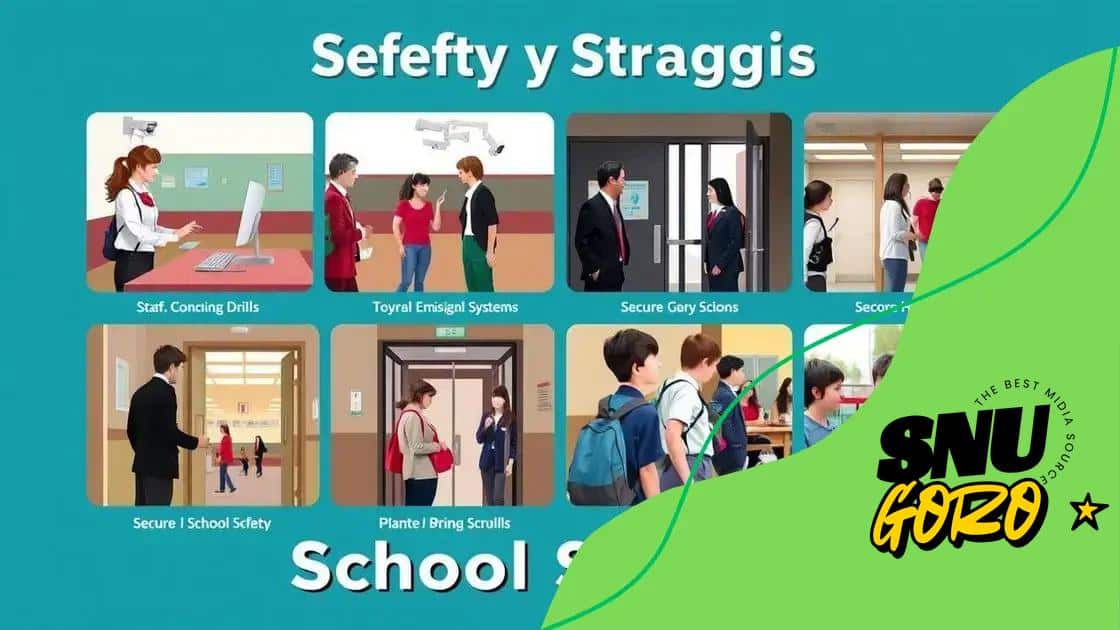Safety in schools: Ensuring a secure environment

Creating a culture of safety in educational institutions involves prioritizing open communication, building positive relationships, providing mental health support, and ensuring effective training for both students and staff.
Safety in schools is a topic that resonates deeply with parents, teachers, and students alike. How can we ensure a secure learning environment for everyone? Let’s dive into strategies that really make a difference.
Understanding the importance of safety in schools
Understanding the importance of safety in schools is essential for creating a conducive learning environment. It affects not only students but also teachers and school staff. A safe school ensures that everyone can focus on learning without worrying about physical threats.
When we think about safety, we should consider various aspects that contribute to a secure atmosphere. Safety in schools isn’t just about preventing violence; it’s also about ensuring health and well-being.
Key Elements of School Safety
There are several elements that make up school safety:
- Physical security measures: This includes secured entrances, fences, and surveillance cameras to monitor the premises.
- Emergency preparedness: Regular drills such as fire, lockdown, or evacuation ensure that everyone knows what to do in case of an emergency.
- Supportive environment: Promoting respect and open communication among students and staff creates a culture of safety.
- Mental health resources: Providing access to counseling helps address emotional and psychological challenges that students may face.
By implementing these strategies, schools can significantly enhance their safety protocols. It’s essential for parents to be aware of what measures are in place so they can contribute to and support these initiatives.
When communities come together to prioritize safety in schools, it fosters a positive environment for learning. This collective effort includes parents, teachers, and local authorities working hand-in-hand to identify and mitigate risks.
In addition, educating students about personal safety can empower them to make better decisions and recognize potential threats. Workshops and discussions about conflict resolution and peer pressure should be part of the curriculum to develop well-rounded individuals.
Ultimately, understanding the importance of safety in schools lays the foundation for student success. When safety is prioritized, students are more likely to thrive academically and socially, which in turn creates a stronger community overall.
Common safety risks and challenges
Identifying common safety risks and challenges in schools is essential for creating a secure environment. When we recognize these risks, we can take proactive steps to mitigate them and enhance safety.
One major challenge is bullying, which can create a hostile environment for students. It affects their mental health and overall academic performance. Schools must implement policies to prevent bullying and promote a culture of respect.
Key Safety Risks
There are several key safety risks that every school should be aware of:
- Violence and crime: This includes potential threats from outsiders or conflicts between students.
- Emergency situations: Natural disasters, fire incidents, or medical emergencies can occur anytime and require immediate response plans.
- Health issues: Outbreaks of illness or poor mental health can significantly impact student well-being.
- Drug and alcohol use: Substance abuse among students can lead to health risks and unsafe behaviors.
In addition to these, schools face the challenge of keeping up with technology. While technology can enhance safety, it can also introduce risks, like cyberbullying or data breaches. Educating students on responsible tech usage is essential.
Moreover, transportation safety is another challenge. Many students travel to school by bus or car, and ensuring their safety during transit is crucial. Proper training for drivers and educating students about safe traveling habits can help reduce accidents.
It’s also important to consider mental health challenges. Many students may struggle with anxiety or depression, which can lead to safety risks both for themselves and others. Schools should provide resources to address these issues effectively.
By understanding these common safety risks and challenges, schools can take the necessary steps to create a safer environment for everyone involved. Engaging the community in discussions about safety can help in developing comprehensive strategies.
Effective strategies for improving school safety

Implementing effective strategies for improving school safety is crucial to protect students and staff. Schools can take numerous actions that create a secure environment for learning and development.
One way to enhance safety is through education. Training staff and students on safety protocols raises awareness and prepares everyone for emergencies. Understanding how to respond to various situations can significantly reduce panic and confusion.
Key Safety Strategies
Several key strategies can be adopted:
- Regular safety drills: Conducting fire drills, lockdown drills, and evacuation exercises ensures everyone knows what to do.
- Improved communication: Establishing clear lines of communication among staff, students, and parents keeps everyone informed about safety measures and emergencies.
- Enhanced physical security: Installing surveillance cameras, secure entrance points, and proper lighting helps deter unauthorized access to the school.
- Mental health support: Providing access to counselors or mental health programs addresses the emotional well-being of students, which can prevent risky behaviors.
In addition, fostering a positive school culture can play a significant role in safety. Encouraging respect and kindness among students promotes a safe and welcoming environment. When students feel valued, they are less likely to engage in harmful behavior.
Another important aspect is involving the community. Schools should collaborate with local law enforcement and parents to develop comprehensive safety plans. Community engagement allows schools to tap into resources and create a more effective safety network.
Furthermore, leveraging technology can also enhance safety. Using apps that allow instant communication in emergencies or monitoring student interactions can help identify and address issues before they escalate.
By combining these strategies, schools can create a robust safety plan that protects everyone. The focus should always be on proactive measures that promote a secure learning environment where students can thrive both academically and socially.
The role of technology in enhancing security
The role of technology in enhancing security within schools is increasingly vital. As technology advances, schools have more tools at their disposal to ensure a safe environment for students and staff.
One significant area is surveillance systems. Cameras placed in key locations can monitor activity and deter potential threats. When students see that they are being watched, it often discourages misbehavior and keeps the environment safer.
Technology Solutions for School Safety
There are various technological solutions that schools can implement:
- Access control systems: These allow only authorized individuals to enter certain areas, enhancing physical security.
- Emergency notification systems: These systems quickly alert staff and students during emergencies through texts, emails, or alarms, providing important information in real-time.
- Mobile safety applications: Many schools use apps that enable students to report suspicious activity or request help instantly. This direct line of communication is crucial for maintaining safety.
- Data analytics: Monitoring trends in school behavior and incidents can help schools identify areas that need attention or improvement.
In addition to these tools, technology can also promote awareness and education. Schools can use online platforms to teach students about safety protocols and how to respond in emergencies. This proactive approach ensures that everyone knows what to do in critical situations.
Students are often tech-savvy, so incorporating technology into safety strategies makes sense. Using familiar tools encourages participation and engagement in safety initiatives, making these programs more effective.
Collaboration with local law enforcement can also enhance technological safety measures. Schools can work together to establish communication networks and utilize law enforcement technology to improve response times and overall safety planning.
Overall, integrating technology into school safety plans not only enhances security but also helps to cultivate a community that prioritizes the well-being of its members. Schools that embrace these advancements can create safer learning environments for everyone.
Creating a culture of safety in educational institutions
Creating a culture of safety in educational institutions is fundamental for promoting a nurturing learning environment. This culture helps everyone feel secure and valued, allowing students and staff to focus on achieving their goals.
To build this culture, schools must prioritize open communication. Encouraging students and staff to voice their concerns creates an atmosphere where safety is everyone’s responsibility. When individuals feel comfortable speaking up, potential issues can be addressed before they escalate.
Key Components of a Safety Culture
There are several key components that contribute to establishing a safety culture:
- Training programs: Regular training for staff and students on safety procedures can help everyone know how to act in emergencies.
- Positive relationships: Building trust among students and staff fosters a sense of belonging. When people feel connected, they are more likely to look out for one another.
- Inclusivity: Ensuring that all voices are heard promotes a sense of ownership over the safety processes in schools. Everyone should be involved in safety discussions.
- Recognizing behavior: Acknowledging students who model safe behaviors encourages others to do the same. Celebrating positive actions reinforces the importance of safety.
In addition to these components, schools should implement regular assessments of their safety policies. This ongoing evaluation identifies areas for improvement and ensures that safety measures remain effective and relevant. Involving students in these assessments can provide valuable insights.
Fostering a culture of safety also requires addressing mental health. Schools should provide resources and support for students facing challenges, as well-educated students are better equipped to contribute positively to the school environment. Mental health education should be integrated into the curriculum.
Ultimately, creating a culture of safety in educational institutions takes commitment and collaboration. When everyone plays an active role in safety efforts, the entire community benefits. Students learn in a positive atmosphere, and teachers can focus on their primary goal—educating and inspiring future leaders.
Creating a culture of safety in schools is essential for fostering a supportive and secure environment for students and staff. By prioritizing communication, building positive relationships, and implementing effective safety strategies, schools can enhance the well-being of everyone involved. Engaging the community and addressing mental health are also critical steps in this process. Together, these efforts can transform educational institutions into places where students feel safe and empowered to learn and thrive.
FAQ – Questions about Creating a Culture of Safety in Educational Institutions
What are the key components of a culture of safety in schools?
The main components include open communication, positive relationships, training, inclusivity, and recognizing safe behaviors.
How can schools effectively communicate about safety?
Schools can encourage students and staff to speak up about concerns and provide regular updates on safety protocols and practices.
Why is mental health support important in school safety?
Addressing mental health helps students cope with challenges and reduces the risk of harmful behaviors, contributing to overall safety.
How can parents and the community get involved in school safety?
Parents and community members can participate in safety discussions, support training programs, and provide resources to enhance safety initiatives.





